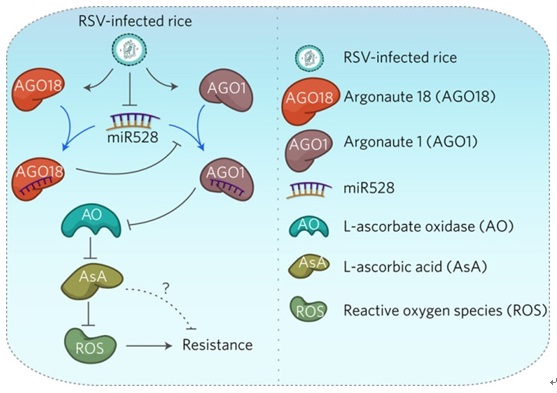Rice stripe virus (RSV) is one of the most destructive pathogens for rice production. RSV has been responsible for numerous epidemics since it was first identified in Japan in 1897. Elucidating the mechanisms of anti-RSV defense in rice will help to control viral epidemics and guarantee food security. Over the past decade, microRNAs (miRNAs) have been identified as key players in plant-microbe interactions. miRNAs are incorporated into AGO1-containing RISCs (RNA-induced silencing complexes) to promote slicing or translational repression of target transcripts. It was reported that some miRNAs are specifically sequestered by AGO18 in RSV infected rice. Therefore, understanding the roles that miRNAs and AGO18 play in anti-RSV defense and manipulating the molecular mechanisms are indispensable for engineering virus-resistant crops.
Researchers from CAO Xiaofeng’s group at the Institute of Genetics and Developmental Biology of Chinese Academy of Sciences and LI Yi’s group at Peking University illustrated the underlying mechanism of miR528 and AGO18 regulatory cascade in antiviral defense.
They found that miR528, a monocot-specific miRNA, negatively regulates viral resistance in rice through association with AGO1-containing RISCs and cleaving L-ascorbate oxidase (AO) messenger RNA, thereby reducing AO-mediated accumulation of reactive oxygen species.
In addition, they found that miR528 could be specifically recruited by AGO18 after RSV infection. Intriguingly, AGO18 is a decoy AGO protein and is incapable of slicing target transcripts. They further showed that AGO18 plays roles by competing with AGO1 for miR528, and releasing miR528 target from slicing or translational repression.
In summary, upon viral infection, miR528 is preferentially sequestered by cleavage-defective AGO18, leading to elevated AO activity, higher basal reactive oxygen species accumulation and enhanced antiviral defense.
This study unearthed a mechanism in which antiviral defense is boosted through suppression of a miRNA that negatively regulates viral resistance. This mechanism could be manipulated by plant breeders to develop virus-resistant crops.
Their scientific paper, entitled “ROS Accumulation and Antiviral Defence Control by MicroRNA528 in Rice”, was online published in
Nature Plants (
DOI:10.1038/nplants.2016.203.)
The research was supported by the National Natural Science Foundation of China.
 |
|
The miR528 and AGO18 regulatory cascade. In rice infected with RSV, miR528 is suppressed by AGO18, leading to the release of AO and higher basal ROS. (Image by IGDB) |
Contact:
Dr. CAO Xiaofeng



